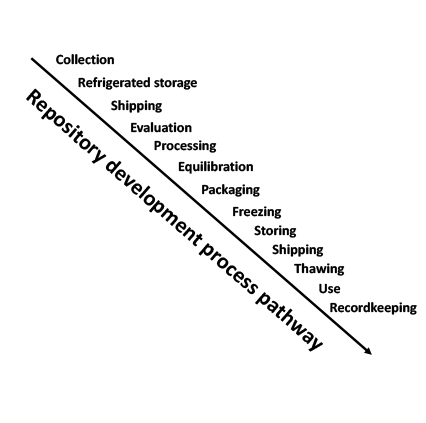Community-Level standardization
With respect to cryopreservation of genetic resources of aquatic species, as indicated above, research activity is restricted to producing data for publication. Small-scale application can produce working material (samples) with low-to-medium throughput, typically without quality assessment. Commercial activities would produce products, potentially numbering in the millions, with high levels of quality management (QM). These are qualitatively different levels of activity: research does not equal application, nor does it necessarily lead to it. Transition across these levels requires innovation for the establishment of new capabilities. However, there is no direct route from innovation to standardization, especially when dealing with modification-oriented research communities. The model we are proposing to lead to standardization recognizes that any innovation (e.g., technology, device, or protocol) introduced to research communities will be subject to a variety of diversification activities (divergence). As user communities begin to adopt and apply the new technology there will be a convergence on the most useful forms (convergence) enabling standardization to emerge

Thus innovation is an individual-level activity, divergence and convergence are user-community mediated, and standardization can emerge through the actions of individuals (perhaps in the private sector by providing products) or by groups with recognized leadership roles, such as stock centers, within user communities. The main point is that standardization cannot be produced by innovation alone.
Technology development
pathway 1:
Capability Level
In this pathway, technologies are developed based on the levels of capabilities from simplest devices to complicated devices. For example, the level-1 technology can be simply 3-D printed assembly that can function without any electrical and automatic elements. But to have more functions and capabilities, complicated elements such as sensing and automation are necessary. As the capability levels goes higher, the device grain more capability and complicity, and more expertise and resources are required to achieve such development. In the AGGRC, interdisciplinary collaborations are formed to address such challenges.

Technology development
pathway 2:
Repository Development Process
It is very important to realize that development of germplasm repositories does not equal to cryopreservation. There are many critical steps within the process that are as important as cryopreservation (or freezing), such as sperm quality evaluation, equilibration, and sample packing. As such, open-source technologies are need in each step to help standardize the whole process.

Inter-disciplinary Collaboration
The AGGRC was developed as an interdisciplinary workspace dedicated to supporting the long-term interactions of individuals spanning fields such as reproductive biology, cryobiology, aquaculture, repository science, veterinary science, economics, computer sciences, biological engineering, mechanical engineering, industrial engineering, electrical engineering, business and marketing, and evolutionary biology. This involves integration of research and technology development and is manifested in core fabrication technologies such as 3-dimensional printing and microfabrication. Ultimately, this goal requires establishment and maintenance of an interdisciplinary culture involving routine interactions and constant creation of new ideas and approaches. It is characterized by rapid change mediated by bringing new people into the group to introduce new capabilities. Individuals must possess certain personality traits including humility, strong communication skills, courage, and creativity to work in such an environment given that much of what transpires is outside of your training and expertise. An interdisciplinary community such as this must also develop a kind of “trade language” (i.e., “Lingua Franca”) to ensure that concepts can be readily exchanged across disciplines. These types of interactions require years to become firmly established, but once established can be readily absorbed by new members such as undergraduates.

One of the major challenges in today’s research environment is to overcome the expanding
differentiation and specialization towards a single field of study (or research model, or
commodity group). This has caused detrimental effects by slowing the pace of discoveries and our
ability to find cures for human and animal diseases. It also greatly diminishes our ability to
bring research into real-world application. When focus is placed on a single or specific area it
diminishes the ability to think broadly, limits options, and can result in an overall narrow
mindset. On the other hand, researchers and technologists working together through
interdisciplinary programs can provide other dimensions to problem solving. This allows
interaction and integration of different mindsets and methodologies, and provides unique
opportunities to share in new thinking processes.
The progression of collaboration from mono-disciplinary to multidisciplinary to
interdisciplinary can be viewed as having the qualities of hierarchical arrangement. The
fundamental collaborative skills will apply at all levels, but as with all hierarchies, movement
to higher levels require qualitative change: things must be done differently, not just more
rapidly or more frequently. Different skills become necessary as we aspire to work outside the
fields in which we received our formal training. Unlike multidisciplinary work where individuals
representing different fields come together often as a team, interdisciplinary work involves
individuals that have developed the capacity to understand and interact with individuals from
other fields in a synthetic way, blending their capabilities into new identities. This means
that people can remain solely as an expert in their own field for multidisciplinary
interactions, but they must broaden their thinking and approach for interdisciplinary work.